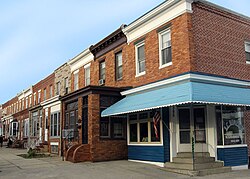Joseph Lee, Baltimore
| Joseph Lee | |
|---|---|
| Neighborhood | |
 |
|
| Country | United States |
| State | Maryland |
| City | Baltimore |
| Neighborhood | Bayview or Hopkins Bayview |
| Established | 1920s |
| Area | |
| • Total | 65 acres (26 ha) |
| Population (2000) | |
| • Total | 2,175 |
| Hospitals | Johns Hopkins Bayview Medical Center |
Joseph Lee, the residential part of Bayview, is a neighborhood in Baltimore, Maryland, United States. Part of the larger Bayview or Hopkins Bayview neighborhood, it borders the Greektown neighborhood. It is sometimes called the "A to K" or "ABC neighborhood" because its north-south streets are arranged in alphabetical order: Anglesea, Bonsal, Cornwall, Drew, Elrino, Folcroft, Gusryan, Hornel, Imla, Joplin, and Kane.
Most of the homes in the community are traditional Baltimore row homes. The earliest houses, built in the 1920s, are in the western portion of the neighborhood and generally have three bedrooms. The houses in the eastern portion, built in the 1950s, typically have two bedrooms. Some have formstone fronts made popular in the 1940s, though these are not as ubiquitous as in Highlandtown. The neighborhood is also known for its azalea bushes that line some of the streets.
The area that comprises today's Joseph Lee neighborhood was part of the Baltimore Canton Company's (founded by Peter Cooper, William Patterson, Robert Oliver, and Columbus O'Donnell) original purchase of 3,000 acres (12 km2) of land in 1828. While most of the development of the land occurred nearer to the waterfront before the 1900s, the company was still involved in the development when the Joseph Lee neighborhood was created. In the book, "Streetwise Baltimore: the stories behind baltimore street names" by Carleton Jones, an entry for "Drew Street" is found on page 66 that reads:
Dan Drew was one of the slipperiest Wall Street customers who ever graced New York, but he also invested in Baltimore's Canton Company. In a 1918 annexation the firm, large east side landowners, christened the street in Drew's name. It is just west of Key Medical Center and leads into and across Eastern Avenue.
The land became part of Baltimore City with the March 29, 1918, annex that expanded the city limits to their present size. The neighborhood was built in the shadow of the existing City Hospitals (Francis Scott Key Medical Center), which housed the Bay View Asylum, acute care, chronic care, and tuberculosis (TB) wards. Construction of the homes in the neighborhood began as early as 1926, beginning on Anglesea and Bonsal streets. By 1933, home construction was complete for the homes through to Cornwall street. New homes continued to be built continuing westward from Drew to Kane Streets through the 1950s.
...
Wikipedia
